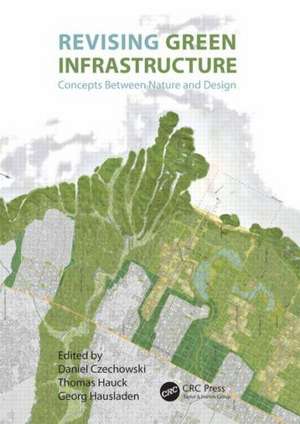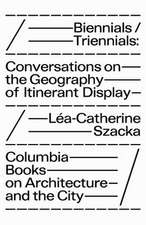Revising Green Infrastructure: Concepts Between Nature and Design
Editat de Daniel Czechowski, Thomas Hauck, Georg Hausladenen Limba Engleză Hardback – 6 noi 2014
- How do we handle the convergence of landscape architecture, ecological planning, and civil engineering?
- What are convenient terms and metaphors to communicate the interplay between design and ecology?
- What are suitable scientific theories and technological means?
- What innovations arise from multidisciplinary and cross-scalar approaches?
- What are appropriate aesthetic statements and spatial concepts?
- What instruments and tools should be applied?
The book explores a scientific functional approach in landscape architecture. It begins with an overview of green functionalism and includes examples of how new design logics are deducted from ecology in order to meet economic and environmental requirements and open new aesthetic relationships toward nature. The contributors share a decidedly cultural perspective on nature as landscape. Their ecological view emphasizes the individual nature of specific local situations.
Building on this foundation, the subsequent chapters present political ideas and programs defining social relations toward nature and their integration in different planning systems as well as their impact on nature and society. They explore different ways of participation and cooperation within cities, regions, and nations. They then describe projects implemented in local contexts to solve concrete problems or remediate malfunctions. These projects illustrate the full scope presented and discussed throughout the book: the use of scientific knowledge, strategic thinking, communication with municipal authorities and local stakeholders, design implementation on site, and documentation and control of feedback and outcome with adequate indicators and metrics.
Although diverse and sometimes controversial, the discussion of how nature is regarded in contrast to society, how human-natural systems could be organized, and how nature could be changed, optimized, or designed raises the question of whether there is a new paradigm for the design of social relations to nature. The multidisciplinary review in this book brings together discussions previously held only within the respective disciplines, and demonstrates how they can be used to develop new methods and remediation strategies.
| Toate formatele și edițiile | Preț | Express |
|---|---|---|
| Paperback (1) | 438.95 lei 43-57 zile | |
| CRC Press – 27 oct 2017 | 438.95 lei 43-57 zile | |
| Hardback (1) | 1023.79 lei 43-57 zile | |
| CRC Press – 6 noi 2014 | 1023.79 lei 43-57 zile |
Preț: 1023.79 lei
Preț vechi: 1447.22 lei
-29% Nou
Puncte Express: 1536
Preț estimativ în valută:
195.90€ • 205.09$ • 162.10£
195.90€ • 205.09$ • 162.10£
Carte tipărită la comandă
Livrare economică 07-21 aprilie
Preluare comenzi: 021 569.72.76
Specificații
ISBN-13: 9781482232202
ISBN-10: 1482232200
Pagini: 488
Ilustrații: 25 black & white illustrations, 176 colour illustrations, 12 black & white tables
Dimensiuni: 156 x 234 x 25 mm
Greutate: 0.96 kg
Ediția:1
Editura: CRC Press
Colecția CRC Press
ISBN-10: 1482232200
Pagini: 488
Ilustrații: 25 black & white illustrations, 176 colour illustrations, 12 black & white tables
Dimensiuni: 156 x 234 x 25 mm
Greutate: 0.96 kg
Ediția:1
Editura: CRC Press
Colecția CRC Press
Cuprins
Part One: Function & Process. Green Functionalism – A brief sketch of its history and ideas in the USA and Germany. Carefully radical or radically careful? Ecology as design motif. The City That Never Was – Engaging Speculative Urbanization through the logics of Landscape. Landscape as energy infrastructure: ecologic approaches and aesthetic implications of design. Landscape Machines, designerly concept and framework for an evolving discourse on living system design. Problems of the Odumian Theory of Ecosystems. Part Two: Culture & Specificity. The Machine and the Garden. Infrastructure design as a catalyst for landscape transformation: research-by-design on the structuring potential of regional public transportation. Beyond Infrastructure and Superstructure – Intermediating Landscapes. Landscapes of variance: working the gap between design and nature. Designing Integral Urban Landscapes – On the End of Nature and the Beginning of Cultures. Counterpoint: The Musical Analogy, Periodicity and Rural Urban Dynamics. Part Three: Governance & Instruments. A transatlantic lens on Green Infrastructure Planning and Ecosystem Services: Assessing Implementation in Berlin and Seattle. The concept of "new nature" – a paradigm shift in how to deal with complex spatial questions. Ecological Network Planning – Exemplary habitat connectivity projects in Germany. Planting the Desert: Cultivating Green Wall Infrastructure. Designing for Uncertainty The Case of Canaan, Haiti . Part Four: Applied Design. Water-Sensitive Design of Open Space Systems Ecological Infrastructure Strategy for Metropolitan Lima, Peru. Green Infrastructure: performance, appearance, economy and working method. The Caribbean Landscape Cyborg: Designing Green Infrastructure for La Parguera, Puerto Rico. Forests and Trees in the City: Southwest Flanders and the Mekong Delta.
Recenzii
"… much of the current work in green infrastructure is either driven by science and technical considerations, and is devoid of design intelligence and the ability to address spatial issues, or it involves unrealistic design visions with little functional relevance or any connection to democratic processes. This book aims to address the gap between these two approaches through the presentation of a range of methods for designing green infrastructure and through the exploration of different relationships between design and ecology. It is dense with examples where authors work through both theoretical explorations, and also the application of ideas in planning and design for green infrastructure. This is an interesting contribution that broadens the professional literature on this topic."
—Topos Magazine, 2015
"This book is a comprehensive overview on green infrastructure from an interdisciplinary and international perspective. The contributions by leading experts offer a broad spectrum of theoretical knowledge, research concepts, design ideas, and strategic advice. For me, Revising Green Infrastructure serves as a reliable source of information and gives inspiration for future research as well as practice."
—Martin Prominski, Gottfried Wilhelm Leibniz Universität Hannover, Germany
"This book gathers perspectives on green infrastructure from engineers, ecologists, and landscape architects. The conversation is more theoretical than practical; it focuses on theories of greenness, research projects, teaching methods, and some best practice examples. Recurring themes include machine analogies, new paradigms, and the relationship between 'nature' and 'culture.' Overall, the book comes from an architectural perspective in which landscapes are seen as manifestations of grand ideas. The book is divided into four sections: function and process, culture and specificity, governance and instruments, and applied design. The first two sections are entirely theoretical. The last two contain some physical relationship to infrastructure, usually urban water conservation and wastewater treatment."
—Ringgold, Inc. Book News, February 2015
"This new book edited by Czechowski, Huack, and Hausladen brings together a collection of 21 papers from a range of 30+ researchers hailing from different countries and understandings of GI: chiefly from the USA and Europe but Haiti, Peru, China, and Vietnam are also represented."
—International Journal of Urban Sustainable Development, Vol. 7, Issues 2, 2015
—Topos Magazine, 2015
"This book is a comprehensive overview on green infrastructure from an interdisciplinary and international perspective. The contributions by leading experts offer a broad spectrum of theoretical knowledge, research concepts, design ideas, and strategic advice. For me, Revising Green Infrastructure serves as a reliable source of information and gives inspiration for future research as well as practice."
—Martin Prominski, Gottfried Wilhelm Leibniz Universität Hannover, Germany
"This book gathers perspectives on green infrastructure from engineers, ecologists, and landscape architects. The conversation is more theoretical than practical; it focuses on theories of greenness, research projects, teaching methods, and some best practice examples. Recurring themes include machine analogies, new paradigms, and the relationship between 'nature' and 'culture.' Overall, the book comes from an architectural perspective in which landscapes are seen as manifestations of grand ideas. The book is divided into four sections: function and process, culture and specificity, governance and instruments, and applied design. The first two sections are entirely theoretical. The last two contain some physical relationship to infrastructure, usually urban water conservation and wastewater treatment."
—Ringgold, Inc. Book News, February 2015
"This new book edited by Czechowski, Huack, and Hausladen brings together a collection of 21 papers from a range of 30+ researchers hailing from different countries and understandings of GI: chiefly from the USA and Europe but Haiti, Peru, China, and Vietnam are also represented."
—International Journal of Urban Sustainable Development, Vol. 7, Issues 2, 2015
Descriere
This book addresses the theme of "green infrastructure" from the perspective of landscape architecture. It brings together the work of selected ecologists, engineers, and landscape architects who discuss a variety of theoretical aspects, research projects, teaching methods, and best practice examples in green infrastructure.











